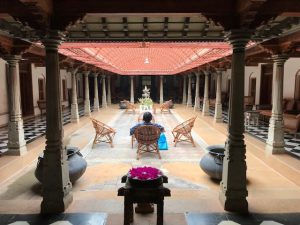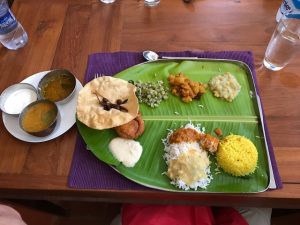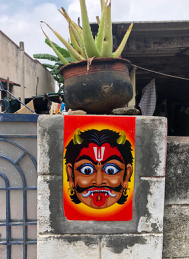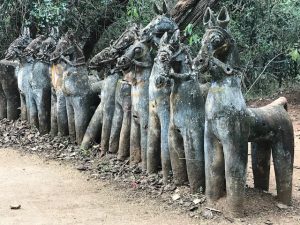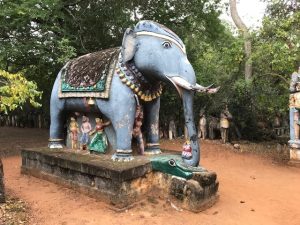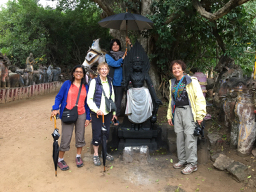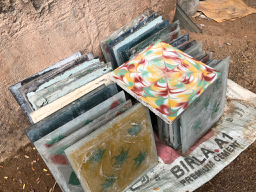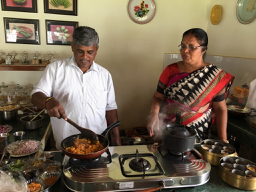I told my group this morning as we left for the Chettinad Region in Tamil Nadu that they will find many people who have toured India but very few who have experienced this extraordinary part of the world. A lost time and place. Large deserted mansions. Long, straight, empty dirt streets with high walls protecting now-disintegrating properties, with few people in sight.
The Chettiars were a prosperous trading people who moved their wives and families inland to this protected part of Tamil Nadu as the men conducted business far and wide across the ocean, often away for many months at a time — who built huge decorated homes from the mid1850’s to the late 1920’s and who then dispersed around India and the world for better economic opportunities after the end of World War II. At least one guide compared the Chettiar traders to the Jews with respect to their acumen for trading and accumulating wealth.
This was a time for us to relax and walk at our own pace around the fascinating village of Kannudakathan, to visit some of the local arts and crafts in neighboring areas, and — most significantly and what will stand out for many of us — to eat absolutely splendid food. Chettinad is known for its special cooking and it did not disappoint. We had 4 gourmet meals in a row, served on banana leaves in high-end boutique hotels, each more delicious than the last. My favorite was the 12-course wedding feast provided to us by the Visalam hotel. Although the food at Saratha Vilas comes a close second, together with our cooking class and lunch at Bangla and the food at Chettinad Mansion. And I didn’t even eat the chicken, mutton, and fish that the others said was splendid. If I ever do a foodie tour of India (maybe a vegetarian foodie tour?), I would definitely center it around here.
There is a local icon in these parts, a fierce Satan-looking guy with a scorpion on his tongue, and I was told that this fierce figure can protect the house so is usually located outside the front door.
Our hotels were spectacular period-pieces and the service was kind and welcoming. There is no hurrying here as there is no place to rush to. Chettiar families come back here to celebrate their major life events and then there are the few tourists, mostly French. There is local agriculture and we visited a weaving center where the product of the looms of over 100 women scattered throughout the region are brought for sale.
Our side trips included an outdoor village temple filled with terra-cotta horses and animals presented to the gods for protection and good fortune;
A tile shop in Athanguidi where concrete tiles are still made the old-fashioned way, hand crafted with a thin layer of colored concrete and then 3/4 inch of concrete to form extremely enduring tile flooring.
And a home where the 5th generation is making traditional Tanjore paintings, built up with plaster of paris, coated with gold foil, and intricately painted. We were not allowed to take photos there, except a group photo when we left, most of us with a fragile package in hand. It was located in a small village which we walked through, everyone happy to greet us with an honorific bow or a gracious hello.
Our Chettinad cooking class, in the largest town of the region, Karaikkudi, was excellent —- even better was eating the food at the end. We seem to have all the ingredients available in Berkeley except perhaps fresh tamarind and small ball shaped chili peppers.
And we should also mention our bullock cart ride around the town, pulled by 2 well groomed white bullocks and skillfully driven by their owner:
Although only a few hours from the major metropolis of Maduri, this Chettinad region is so distinctly different from anyplace else in India and I am so glad we were able to relax and enjoy our time here together.





